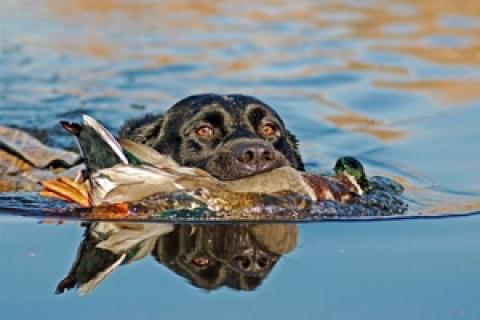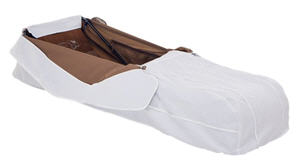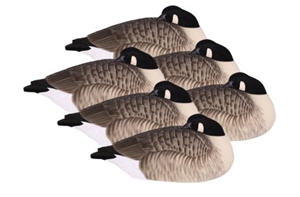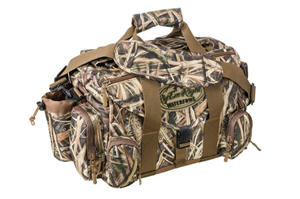
In the South, some tornadoes are to be feared; others are to be welcomed.
This tornado was in the latter category. It was a cyclone of ducks — a vortex of rushing noise and wind. There were 500 or more birds circling over the flooded field above us. As we peered through the brush, other flights were coming in high to join the swarm. We fingered our shotguns' safeties and waited for just the right time to come up shooting. It was a moment that has been forever etched in my waterfowling memory.
Big Rivers are Natural Flyways for Birds
Several major rivers snake through the lower half of the United States: Mississippi, lower Ohio, lower Missouri, Arkansas, Tennessee, Cumberland and others. These are natural flyways for a large segment of North America's waterfowl population. When the migration is on, these big rivers are funnels for birds heading south.
 |
| Hunters who "run and gun" can find some great shooting on North America's big rivers. Being mobile allows hunters to scout to find birds, then to set up quickly for the next passing flight. Photo by Travis Mueller, Avery Outdoors |
And they are open and accessible to public hunting. Major rivers are dotted with ramps that can serve as jump-off points for real adventure. Islands, sloughs, sandbars, willow chutes and adjoining bottoms all offer potential for great shooting when conditions are right. Plus, the only restrictions on river hunting are those imposed by basic season dates and bag limits.
But a strong word of caution: hunting on the South's big rivers should not be undertaken by the irresponsible or ill-prepared. While offering potential, these waters can also be treacherous. Hunters heading out on a big river should know what they're facing and take precautions to keep their hunt from turning into a search-and-rescue mission.
Here's how to hunt these big rivers: when to go, what to take, simple hunting strategies, and how to stay safe. Truly, these waterways are the last frontier of duck and goose hunting adventure that's accessible to one and all.
When to Hunt on Big Rivers
Big rivers can offer good waterfowl hunting anytime, but chances are best during a drought, a freeze or a flood.
During a drought, ducks and geese are pushed to rivers by a lack of water in flooded fields, swamps, beaver sloughs, and other shallow wetlands. Usually a river's level is low during this condition, exposing sandbars, wing dams and other features that create eddies where birds can rest out of the current. Sometimes enormous rafts of ducks build up in these calm waters in mid-day periods. After feeding in the morning, they gravitate to these places to loaf and collect grit for their craws.
A hard freeze also makes shallow wetlands inaccessible to ducks and geese. But when these shallows lock up, big rivers stay open because of their current and depth. Thus the birds must shift locations to keep their feet wet. Again, they gravitate toward eddies and sandbars in mid-morning after eating their breakfast in dry grainfields.
A flood draws waterfowl for a different reason: new food sources and resting areas are progressively available as the floodwaters rise. This normally draws ducks and geese in large concentrations, and they come eager to work. And when they're not feeding, there's usually an abundance of flooded timber, willow brakes and brushy cover where the birds can rest with a sense of protection.
Big rivers can offer good hunting during other times and conditions, but these are the best. Keep a watch on river stages (i.e., water levels) on U. S. Army Corps of Engineers web sites, and plan to hunt rivers when they're very low, very high or during a prolonged sub-freezing spell.
What to Take When River Hunting Waterfowl
 |
| Cabela's Northern Flight Layout Blind Snow Cover |
River hunting is all about portability and versatility. Hunters should be able to cover a lot of river mileage looking for birds, then set out waterfowl decoys and hide wherever they're found.
So, the first necessity for river hunting is a large, seaworthy boat with a big outboard and enough gas to run for miles in strong current.
Many hunters rig portable hunting blinds on their river boats. These blinds are very effective in high-water conditions when the boat can be pulled into brush or willows.
 |
| Avian-X Topflight Black Duck Decoys |
However, when the water is low, hunters must figure ways to disappear in the wide open. One good way to do this is to hunt from layout hunting blinds like the Cabela's Northern Flight Mobile Elite Layout Blind Snow Cover set up at water's edge on sandbars and island points. Another option for hunting in the open is a temporary pit that is camouflaged with driftwood or switch willows. And a third option is a layout boat beached in shallow water or at the edge of a sandbar. With any of these three, the idea is to totally vanish in the surroundings. Doing anything less will likely result in scared birds and empty bags.
Duck Decoy Rules
When hunting on rivers, the rule for duck decoys is: the more, the better. Especially on open water, a big spread will pull more birds because of its added visibility. Hunters setting up in flooded backwaters may get by with 2-3 dozen decoys, but open water hunters should consider tossing out 100 or more. Anchor strings should be adjustable to match varying water depths. Decoy anchors should be heavy enough to hold in strong winds and currents. Duck decoys should be wrapped and placed in a decoy bag for easy transport in the boat and convenient deployment when a hunting site is selected.
 |
| Hard Core Rugged Series Canada Goose Sleeper Shell at Cabelas.com |
Goose decoys are bulky, and shell decoys get the nod over full-bodies. Goose shell decoys like the Hard Core Rugged Series Canada Goose Sleeper Shell decoy with sleeper heads offer an extremely realistic look for a sandbar set. Also, motion stakes should be used with some of the shell decoys to impart movement to the spread.
 |
| ++SHELL SHOCKER BLIND BAG |
River hunters may choose from any of a long list of other freelance-hunting gear, customizing their selections to their particular needs and desires: heaters, seats, shotshell bags, flags, GPS, etc.
River Duck Hunting Strategies
There is one main strategy for hunting rivers: cover water and search for birds. Ducks and geese won't scatter randomly along these waterways. Instead, they will concentrate where feeding and resting conditions are best. You find these places by running and looking. Launch your boat at dawn, and don't forget the binoculars!
When you jump a raft of birds (typically 50 or more; not a small flight), move in and set up exactly where they were on the water, if possible. They were there for a reason, and the same spot will look attractive to the next flight coming down the river.
 |
| Veteran river hunters know that a capable retriever can save them a lot of work once birds are on the water. A good dog can recover birds without having to break the blind down and chase them in the boat. Photo courtesy of Avery Outdoors |
However, before tossing out your decoys, figure out how to hide. Decide where to position your boat-blind to take advantage of natural cover and shadows. On a high water, I like to wedge my boat-blind beneath the overhanging branches of a bushy tree. Then I'll use pruners (kept in my boat's dry box) to trim away branches for clear shooting over the decoys. However, I leave as much overhead cover as possible to hide from circling ducks' prying eyes.
If hunting in switch willows or brush, I'll push the boat into this cover at least 5 yards instead of setting up on the edge of the hole. Then I'll cut natural vegetation to pile on the boat to help it blend in.
However, if the spot isn't conducive to hunting from a boat, I'll hide on land, stand in shallow water, or do whatever is necessary to hunt as close to the "magic spot" as possible. I've laid on mudflats beside driftwood logs. I've dug pits in sandbars. I've built rock blinds on jetties.
But this was before layout blinds were available! Nowadays these portable one-man blinds can be deployed effectively and quickly on sandbars and clean banks. Hunters might dig them in a few inches. They should be "mudded" to blend into the terrain. They might be camouflaged with other materials at hand. But the point is, using layout blinds opens a vast new range of opportunities for hiding in open areas where ducks and geese are working.
Calling to river ducks and geese is often a matter of "call loudly, call a lot". This may be necessary to attract birds that are passing at long distance. (When goose hunting, don't forget the goose flags!) If, however, you are set up in the very spot where they're coming, little or no calling may be the best option. Let each new situation and the reaction of the birds dictate how much you call.
![]() Tip: Shop duck calls and goose calls at Bass Pro Shops here.
Tip: Shop duck calls and goose calls at Bass Pro Shops here.
![]() Tip: Shop Goose calls at Cabela's here.
Tip: Shop Goose calls at Cabela's here.
Ducks and Geese Flock to Rivers
Finding good waterfowl hunting is becoming more difficult as choice private lands are leased up and public hunting areas draw larger crowds. But big rivers remain wide open for those who venture upon them. Hunters who learn to ply these big waters can sometimes experience legendary shooting, and the only cost is their endeavor.
Indeed, ducks and geese flock to the rivers' sandbars, sloughs and slashes. They are as wild as the waters they frequent, and they will thrill the souls of hunters who find them there. That's the way it was for my friends and me on the Ohio River that morning of glory, and so many times since. Big rivers yield grand adventure when the "push" is on.
- 9622 views

